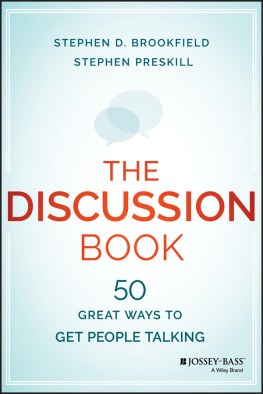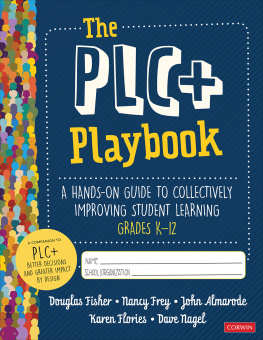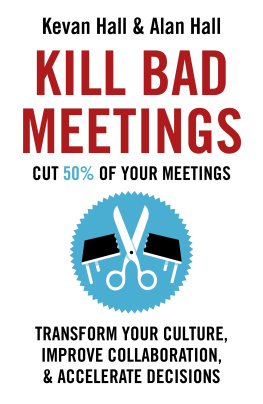
Copyright 2016 by John Wiley & Sons, Inc. All rights reserved.
Published by Jossey-Bass
A Wiley Brand
One Montgomery Street, Suite 1000, San Francisco, CA 94104-4594www.josseybass.com
No part of this publication may be reproduced, stored in a retrieval system, or transmitted in any form or by any means, electronic, mechanical, photocopying, recording, scanning, or otherwise, except as permitted under Section 107 or 108 of the 1976 United States Copyright Act, without either the prior written permission of the publisher, or authorization through payment of the appropriate per-copy fee to the Copyright Clearance Center, Inc., 222 Rosewood Drive, Danvers, MA 01923, 978-750-8400, fax 978-646-8600, or on theWeb at www.copyright.com. Requests to the publisher for permission should be addressed to the Permissions Department, John Wiley & Sons, Inc., 111 River Street, Hoboken, NJ 07030, 201-748-6011, fax 201-748-6008, or online at www.wiley.com/go/permissions.
Limit of Liability/Disclaimer ofWarranty: While the publisher and author have used their best efforts in preparing this book, they make no representations or warranties with respect to the accuracy or completeness of the contents of this book and specifically disclaim any implied warranties of merchantability or fitness for a particular purpose. No warranty may be created or extended by sales representatives or written sales materials. The advice and strategies contained herein may not be suitable for your situation. You should consult with a professional where appropriate. Neither the publisher nor author shall be liable for any loss of profit or any other commercial damages, including but not limited to special, incidental, consequential, or other damages. Readers should be aware that InternetWeb sites offered as citations and/or sources for further information may have changed or disappeared between the time this was written and when it is read.
Jossey-Bass books and products are available through most bookstores. To contact Jossey-Bass directly call our Customer Care Department within the U.S. at 800-956-7739, outside the U.S. at 317-572-3986, or fax 317-572-4002.
Wiley publishes in a variety of print and electronic formats and by print-on-demand. Some material included with standard print versions of this book may not be included in e-books or in print-on-demand. If this book refers to media such as a CD or DVD that is not included in the version you purchased, you may download this material at http://booksupport.wiley.com. For more information about Wiley products, visit www.wiley.com.
Library of Congress Cataloging-in-Publication Data is Available:
ISBN 978-1-119-04971-5 (paper)
ISBN 978-1-119-05091-9 (ePDF)
ISBN 978-1-119-05096-4 (ePUB)
Cover design by Wiley
FIRST EDITION
Preface
This is a short book so this will be a short preface.
The two of us have long wanted a brief and accessible booka manual, reallythat collected the best techniques to start discussion, keep it going, and stay focused. This would be the kind of book you could stuff into a pocket or purse as you walked to chair a meeting, teach a class, or run a professional development workshop. On the way you could scan it to get a couple of new techniques to try out that day. To paraphrase Dragnet's Joe Friday, we wanted a manual containing just the facts ma'am or, rather, just the techniques.
Audience
Our audience for this book is probably the largest one either of us has ever written for. Essentially we hope that anyone who uses some kind of group discussion process in any setting at all will find it valuable. The convener of a corporate decision-making meeting or the leader of a community town hall or congregation will find this just as beneficial as will a classroom teacher.
We have tried out these techniques in an incredible variety of settings. In addition to the hundreds of schools and colleges we have worked with, these have been used in places as varied as the Occupy movement, corporations (including IBM, 3M, CA Technologies, ARCO Oil), postHurricane Sandy community groups, the military, health care organizations, churches, and nonprofit organizations such as the Theater Development Fund in New York. Educational institutions using them have been as diverse as fashion institutes, schools of mining, chiropractic and Asian medicine colleges, schools for the deaf, seminaries, tribal colleges, and, of course, multiple two- and four-year colleges and universities.
So, if you're looking for some quick and easy techniques to try out in your meetings, workshops, or classrooms that will get people participating, focus the conversation, and keep the energy level high, then this is the book for you!
Overview of Contents
This book doesn't have traditional chapters, just a listing of fifty techniques we find applicable for multiple purposes in multiple settings, We imagine readers approaching a meeting, class, or workshop thinking, I need to get more discussion going today, as a group we need to listen better to what each other is saying, or how am I going to democratize the session today so more people participate?
We created a brief user guide to the book that identifies ten categories, each of which identifies a particular purpose the techniques are suited to. If this is your first time working with a group, you'd go to the first category on getting discussions going and consider trying something from there. If you feel that a few people are dominating the conversation then you'd consult the category on democratizing participation and select one of the ten techniques listed.
This means you as a reader don't need to look through a list of fifty techniques and pick one that fits. And you don't need to go through this book sequentially. Instead you can start with whichever of the following categories that seem to address your situation the best and see if any of the techniques listed there could work with your group.
- Top Ten Techniques to Get Discussion Going with New Groups
- Top Ten Techniques to Promote Good Questioning
- Top Ten Techniques to Foster Active Listening
- Top Ten Techniques for Holding Discussions without Speech
- Top Ten Techniques to Get People out of their Comfort Zone
- Top Ten Techniques for Text-Based Discussions
- Top Ten Techniques to Democratize Participation
- Top Ten Techniques to Transition from Small to Large Groups
- Top Ten Techniques for Building Group Cohesion
- Top Ten Techniques for Discussions Requiring a Decision
Because many of the techniques we use show up in multiple categories, we end with a list of the Top Ten Techniques That Best Serve Multiple Discussion Purposes.
Website
As an accompaniment to the book we have created a website devoted to it: www.thediscussionbook.com/. There you can find out how to contact us, reviews and applications of the techniques we've used, and examples of other techniques we couldn't fit into a short manual.
User Guide
Top Ten Techniques to Get Discussion Going with New Groups
- Circle of Voices
- Chalk Talk
- Participation Rubric
- Think-Pair-Share
- Today's Meet
- Appreciative Pause
- Single Word Sum-Ups
- Setting Ground Rules
- The Three-Person Rule
- Quick Writes
Top Ten Techniques to Promote Good Questioning
- Strategic Questioning
- Open-ended Questions
- Nominating Questions
- If You Could Only Ask One Question
- On-the-Spot Questions
- What Do
Next page







